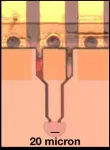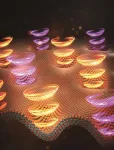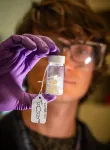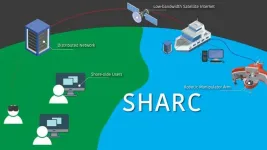(Press-News.org) For the first time, researchers have used a surface normal nonlinear photodetector (SNPD) to improve the speed and energy efficiency of a diffractive optical neural network (ONN). The new device lays the groundwork for large-scale ONNs, which can perform high-speed processing at the speed of light in an extremely energy efficient manner.
Farshid Ashtiani from Nokia Bell Labs will present this research at Frontiers in Optics + Laser Science (FiO LS), which will be held 9 – 12 October 2023 at the Greater Tacoma Convention Center in Tacoma (Greater Seattle Area), Washington.
“Artificial intelligence (AI) is playing increasingly important roles in our lives. From large language models to autonomous cars, we see significant improvements enabled by AI,” explains Ashtiani. “Neural networks, inspired by how the human brain learns and performs various tasks, are at the heart of the progress in AI. One of the widespread applications of neural networks is recognizing patterns and objects, which gives vision to machines. For instance, every autonomous car, or even semi-autonomous car, must understand its surroundings by being able to see things.“
“Conventionally, images are taken by cameras, converted to electrical signals, and processed using electronic processors such as CPUs or GPUs for object recognition,” said Mohamad Hossein Idjadi, Nokia Bell Labs. “However, since the images are originally in optical domain (i.e., light), it can be faster and more energy efficient to process them optically using ONN. Among different technologies, ONNs based on spatial light modulators enable the optical processing of high-resolution images and videos. This processing requires nonlinear modules and camera sensors are conventionally used to introduce this needed nonlinearity, which takes several milliseconds. Our novel detector device makes this nonlinear processing 1000 times faster and more energy efficient than such cameras. This is crucial for the next generation of machine vision systems as we all need even faster intelligent gadgets that do not consume a lot of energy.”
Free-space diffractive ONNs use spatial light modulators and are particularly promising for creating the large-scale networks of neurons necessary for image and video processing. However, the speed and energy efficiency of this type of ONN is usually limited by the image sensor used to implement the nonlinear activation function that implements multiple layers of neurons to create a deep neural network.
In the new work, the researchers proposed the use of an SNPD, that they had previously demonstrated as a high-speed electro-optic modulator, in high resolution diffractive ONNs. Testing showed that the SNPD had a 3-dB bandwidth of 61 kHz corresponding to less than 6 microseconds— about 1000 times faster than the typical response time of camera sensors conventionally used in such ONNs. The sensor also consumes only about 10 nW/pixel, which is three orders of magnitude more efficient than a typical camera.
To test the new sensor in an ONN, the researchers input images into the convolution layer – the primary building block of the neural network. The convolution layer had 32 parallel 3 × 3 kernels with a stride of one and used the actually measured SNPD response as its activation function instead of the standard rectified linear activation function. With this simulation setup, the network achieved a test classification accuracy of about 97%, which is the same performance as using an ideal rectified linear activation function in the same network.
The research demonstrates the potential of using a SNPD in free-space diffractive ONNs. The fact that the detector is three orders of magnitude faster and more efficient than a camera makes it a promising candidate for use in large scale free-space ONN setups.
“We need to make a large number of our detector devices, potentially millions of them, to build a full vision system, and to compete with the high resolution provided by conventional cameras,” added Stefano Grillanda, Nokia Bell Labs. “The good news is that this is technologically possible. Another avenue to look into is to further reduce the footprint, energy consumption, and response time of the detector to make it an even better solution for future AI vision systems.”
About Frontiers in Optics + Laser Science
Frontiers in Optics, the annual meeting for Optica (formerly OSA) is presented with Laser Science, the annual meeting of the American Physical Society, Division of Laser Science. The two meetings unite communities from both societies for comprehensive and current research in a diverse collection of optics and photonics topics and across the disciplines of physics, biology and chemistry. The 2023 FiO LS Conference will be held as an in-person event featuring hundreds of live contributed and invited talks with additional on-demand content available for online viewing. Media registration is free with credential. Digital assets are available as requested.
About Optica
Optica (formerly OSA), Advancing Optics and Photonics Worldwide, is the society dedicated to promoting the generation, application, archiving and dissemination of knowledge in the field. Founded in 1916, it is the leading organization for scientists, engineers, business professionals, students and others interested in the science of light. Optica’s renowned publications, meetings, online resources and in-person activities fuel discoveries, shape real-life applications and accelerate scientific, technical and educational achievement. Discover more at: Optica.org
Media Contact
mediarelations@optica.org
END
New detector paves the way to large-scale optical neural networks
Faster, energy-efficient diffractive ONN could be used for image and video processing
2023-08-24
ELSE PRESS RELEASES FROM THIS DATE:
The right combo: Getting the most health benefits from fruit smoothies
2023-08-24
Smoothies can be a tasty and convenient way to get the important fruits and vegetables you need for a healthy diet. But is a banana and blueberry smoothie the best combo? Researchers at the University of California, Davis, suggest that blending certain ingredients in smoothies can influence whether your body is getting a nutritional boost.
The study, published today in the Royal Society of Chemistry’s journal Food and Function, used smoothies to test how various levels of polyphenol oxidase, an enzyme in many fruits and vegetables, affects the levels of flavanols in food to be absorbed by the body. Flavanols ...
$12 million grant funds foundational research on early liver transplantation
2023-08-24
Alcohol-associated liver disease accounts for 50% of liver-related deaths, and its rates are rising worldwide. But one of the best treatment options, early liver transplantation (ELT)—transplants done with no mandatory period of abstinence from alcohol—is also one of the most controversial, partly because of concerns that patients will relapse to alcohol after transplantation.
Part of the problem is that livers for transplants are in short supply, and researchers lack data to determine who will benefit most from ELT. Studies show that decisions about who gets a transplant can, at times, be influenced by bias or unsystematic. ...
Study shows technology boosts public health programs
2023-08-24
An examination of the SCALE-UP Counts program was recently published in the journal Pediatrics. This analysis, led by Yelena Wu, PhD, investigator at Huntsman Cancer Institute and associate professor in the department of dermatology at the University of Utah (the U), and David Wetter, PhD, MS, investigator at Huntsman Cancer Institute and professor in the department of population health sciences at the U, received support from RADx-Underserved Populations (RADx-UP) and funding from the National Institute of Health (NIH).
The SCALE-UP Counts program was designed to promote COVID-19 testing through collaboration ...
A global observatory to monitor Earth's biodiversity
2023-08-24
At a time of nature crisis driven by unparalleled rates of biodiversity loss, a new interconnected system to monitor biodiversity around the world is urgently needed to direct and focus conservation action.
"The lethal combination of habitat loss, the exploitation of natural populations, pollution, and climate change is causing species extinction rates not seen since the last mass extinction 65 million years ago," said Prof. Andrew Gonzalez, Liber Ero Chair in Conservation Biology at McGill University, and co-Chair of GEO BON. "We lack the means to monitor these impacts ...
High drug price associated with decreased treatment retention for patients with chronic liver disease
2023-08-24
MINNEAPOLIS/ST. PAUL (08/24/2023) — Researchers from the University of Minnesota Medical School and College of Pharmacy have found that high costs for hepatic encephalopathy treatment in patients with end-stage liver disease were associated with decreased treatment retention for patients. The study results were recently published in Hepatology Communications.
Hepatic encephalopathy is the loss of brain function that occurs in people with severe liver disease. The condition is associated with high morbidity and mortality. ...
Optimizing tobacco cessation treatment with lung cancer screening
2023-08-24
MINNEAPOLIS/ST. PAUL (08/24/2023) —Lung cancer is the deadliest cancer in the United States, and 80% of lung cancer deaths are linked to one risk factor: smoking. While lung cancer screenings are a critical part of prevention and treatment for the disease and 15 million Americans qualify for yearly screenings, over half those eligible for screenings are still actively smoking. Without standard smoking cessation measures in place, the benefits of the screenings have not been fully realized.
New ...
New quantum device generates single photons and encodes information
2023-08-24
A new approach to quantum light emitters generates a stream of circularly polarized single photons, or particles of light, that may be useful for a range of quantum information and communication applications. A Los Alamos National Laboratory team stacked two different, atomically thin materials to realize this chiral quantum light source.
“Our research shows that it is possible for a monolayer semiconductor to emit circularly polarized light without the help of an external magnetic field,” ...
Making materials more durable through science
2023-08-24
ALBUQUERQUE, N.M. — A team at Sandia National Laboratories developed a molecule that helps change the way some materials react to temperature fluctuations, which makes them more durable. It’s an application that could be used in everything from plastic phone cases to missiles.
Polymers, which include various forms of plastics, are made up of many smaller molecules, bonded together. This bond makes them especially strong and an ideal product to be used to protect delicate components in a wide variety of items. But with time, use and exposure to different environments, all materials begin to deteriorate.
Hot ...
New framework for oceanographic research provides potential for broader access to deep sea scientific exploration
2023-08-24
Woods Hole, Mass. (August 23, 2023) -- Scientific exploration of the deep ocean has largely remained inaccessible to most people because of barriers to access due to infrastructure, training, and physical ability requirements for at-sea oceanographic research.
Now, a new and innovative framework for oceanographic research provides a way for shore-based scientists, citizen scientists, and the general public to seamlessly observe and control robotic sampling processes.
The Shared Autonomy for Remote Collaboration (SHARC) framework “enables remote participants to conduct shipboard operations and control ...
How pre-eclampsia accelerates aging in women
2023-08-24
ROCHESTER, Minnesota — Pre-eclampsia, a life-threatening surge in blood pressure, is an enigmatic condition. Each year, it causes the deaths of more than 70,000 women worldwide. Because scientists do not know what causes it, they lack targeted strategies to treat it.
Delivery, the only available therapy, is not the cure it is often made out to be, according to Vesna D. Garovic, M.D., Ph.D., a nephrologist at Mayo Clinic in Rochester, Minnesota, who has devoted her career to studying this common pregnancy complication.
"Even after delivery, women ...
LAST 30 PRESS RELEASES:
Numbers in our sights affect how we perceive space
SIMJ announces global collaborative book project in commemoration of its 75th anniversary
Air pollution exposure and birth weight
Obstructive sleep apnea risk and mental health conditions among older adults
How talking slows eye movements behind the wheel
The Ceramic Society of Japan’s Oxoate Ceramics Research Association launches new international book project
Heart-brain connection: international study reveals the role of the vagus nerve in keeping the heart young
Researchers identify Rb1 as a predictive biomarker for a new therapeutic strategy in some breast cancers
Survey reveals ethical gaps slowing AI adoption in pediatric surgery
Stimulant ADHD medications work differently than thought
AI overestimates how smart people are, according to HSE economists
HSE researchers create genome-wide map of quadruplexes
Scientists boost cell "powerhouses" to burn more calories
Automatic label checking: The missing step in making reliable medical AI
Low daily alcohol intake linked to 50% heightened mouth cancer risk in India
American Meteorological Society announces Rick Spinrad as 2026 President-Elect
Biomass-based carbon capture spotlighted in newly released global climate webinar recording
Illuminating invisible nano pollutants: advanced bioimaging tracks the full journey of emerging nanoscale contaminants in living systems
How does age affect recovery from spinal cord injury?
Novel AI tool offers prognosis for patients with head and neck cancer
Fathers’ microplastic exposure tied to their children’s metabolic problems
Research validates laboratory model for studying high-grade serous ovarian cancer
SIR 2026 delivers transformative breakthroughs in minimally invasive medicine to improve patient care
Stem Cell Reports most downloaded papers of 2025 highlight the breadth and impact of stem cell research
Oxford-led study estimates NHS spends around 3% of its primary and secondary care budget on the health impacts of heat and cold in England
A researcher’s long quest leads to a smart composite breakthrough
Urban wild bees act as “microbial sensors” of city health.
New study finds where you live affects recovery after a hip fracture
Forecasting the impact of fully automated vehicle adoption on US road traffic injuries
Alcohol-related hospitalizations from 2016 to 2022
[Press-News.org] New detector paves the way to large-scale optical neural networksFaster, energy-efficient diffractive ONN could be used for image and video processing





